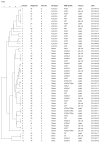Salmonella Infection in Nursery Piglets and Its Role in the Spread of Salmonellosis to Further Production Periods
- PMID: 33504097
- PMCID: PMC7911055
- DOI: 10.3390/pathogens10020123
Salmonella Infection in Nursery Piglets and Its Role in the Spread of Salmonellosis to Further Production Periods
Abstract
Few studies have focused on assessing Salmonella infection in the nursery and its role in further pig production periods. Mesenteric lymph nodes, intestinal content, and meat juice from 389 6-week-old male piglets intended for human consumption from five breeding farms and 191 pooled floor fecal samples from gilt development units (GDU) from the same farms were analyzed to estimate and characterize (by pulsed-field gel electrophoresis and antimicrobial resistance analyses) Salmonella infection. The prevalence of infection and shedding among piglets was 36.5% and 37.3%, respectively, shedding being significantly associated with infection (Odds Ratio = 12.7; CI 7.3-22.0). Salmonella Rissen; S. 4,[5],12:i:-; and S. Derby were the most common serotypes. A low level of Salmonella-specific maternal antibodies at the beginning of the nursery period suggested it was a period of high risk of infection. Resistance to 3rd- and 4th-generation cephalosporins was detected in piglet isolates although the piglets never received antibiotics, indicating they could be vectors of antimicrobial resistance. The same Salmonella clones were detected in piglet and GDU isolates, suggesting that infected piglets play a significant role in the infection of gilts and consequently of finishing pigs in the case of production farms. The control of Salmonella infection in nursery piglets may decrease the risk of abattoir and carcass contamination.
Keywords: PFGE; Salmonella; nursery piglets; prevalence; shedding; swine; zoonoses.
Conflict of interest statement
The authors declare no conflict of interest.
Figures

References
-
- European Food Safety Authority (EFSA) Report of the Task Force on Zoonoses Data Collection on the analysis of the baseline survey on the prevalence of Salmonella in slaughter pigs in the EU, 2006–2007. Part A: Salmonella prevalence estimates. EFSA J. 2008;135:1–111. doi: 10.2903/j.efsa.2008.135r. - DOI
-
- Alban L., Baptista F.M., Møgelmose V., Sørensen L.L., Christensen H., Aabo S., Dahl J. Salmonella surveillance and control for finisher pigs and pork in Denmark—A case study. Food Res. Int. 2012;45:656–665. doi: 10.1016/j.foodres.2011.02.050. - DOI
Grants and funding
LinkOut - more resources
Full Text Sources
Other Literature Sources

